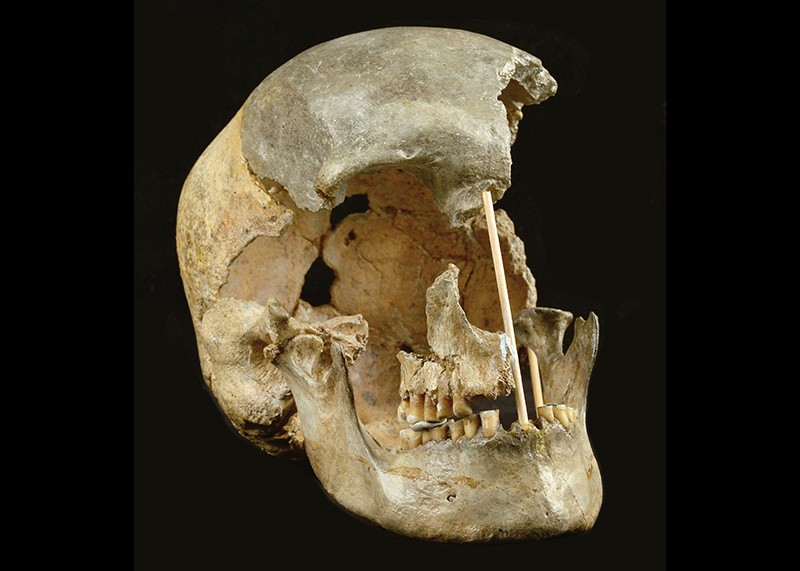Analysis of the ancient DNA of Neanderthals and early modern humans has recently shown that the groups likely interbred somewhere in the Near East, after modern humans left Africa about 50 years ago. As a result, all people outside of Africa carry around 2% to 3% of Neanderthal DNA.
In modern human genomes, these Neanderthal DNA segments have become shorter and shorter over time, and their duration can be used to estimate when an individual has lived.
Archaeological data, published last year, further suggest that modern humans were already present in southeastern Europe 47-43 years ago, but due to the scarcity of fairly complete human fossils, and the lack of genomic DNA, there is little understanding of who these first human settlers were – or their relationships with ancient and current human groups.
In a new study published days ago in magazine Nature Ecology & Evolution , an international team of researchers reports what is probably the oldest modern human genome sequenced to date.
First discovered in the Czech Republic, the woman of the species Homo sapiens, known to researchers as Zlatý kůň (Golden Horse in Czech), exhibited longer stretches of Neanderthal DNA than the 45-year-old Ust'-Ishim individual found in Siberia, which was the oldest modern human genome until recently. known.
Genetic analysis suggests that she, Zlatý kůň, was part of a population that formed before the populations that gave rise to the split between Europeans and Asians today.
A recent anthropological study based on the shape of the Zlatý kůň skull showed similarities to people living in Europe before the Last Glacial Maximum – at least 30 years ago – but radiocarbon dating had produced contradictory results, some indicating that the skull would only have 15 thousand years.
It was only when Jaroslav Brůžek, from the Faculty of Science in Prague, and Petr Velemínský, from the National Museum in Prague, collaborated with the genetic laboratories of the Max Planck Institute for the Science of Human History that it was possible to clarify the contradictions between the various types of dating.
“We found evidence of cow DNA contamination in the analyzed bone, suggesting that a bovine-based glue used in the past to consolidate the skull was producing radiocarbon dates more recent than the fossil's true age,” he says. Cosimo Posth, co-lead author of the study, in a statement from the Max Planck Institute.
Posth was previously a research group leader at the Max Planck Institute for the Science of Human History and is currently Professor of Archaeo and Paleogenesis at the University of Tübingen in Germany.
However, it was Neanderthal DNA that led the team to their main conclusions about the age of the fossil. Zlatý kůň contained approximately the same amount of Neanderthal DNA in its genome as Ust Ishim or other modern humans outside of Africa, but segments with Neanderthal ancestry were, on average, much longer.
“The results of our DNA analysis show that Zlatý kůň lived closer to the time of the mixing event with Neanderthals,” explains Kay Prüfer, co-author of the study, in the statement cited above.
Scientists were able to estimate that Zlatý kůň lived approximately 2 years after crossing with Neanderthals from its ancestors.
Based on these findings, the team argues that Zlatý kůň represents the oldest human genome sequenced to date.
“It is quite intriguing that the first modern humans in Europe were not successful! As with Ust'-Ishim and the oldest European skull so far in Oase 1, Zlatý kůň does not show any genetic continuity with modern humans who lived in Europe 40 years ago,” comments Johannes Krause, lead author of the study and director of the Max Planck Institute for Evolutionary Anthropology.
One possible explanation for the discontinuity is the volcanic eruption. Campanian Ignimbrite occurred some 39 years ago, which severely affected the climate in the northern hemisphere and may have reduced the chances of survival for Neanderthals and early modern humans in large parts of Ice Age Europe.
As advances in ancient human DNA sequencing reveal more about the history of our species, future genetic studies of other early European individuals will help reconstruct the history and decline of the first modern humans to expand outside Africa and for Eurasia, before the formation of non-African populations of modern times.
Author António Piedade is a Biochemist and Science Communicator. He published over 700 articles and chronicles of scientific dissemination in the Portuguese press and 20 articles in international scientific journals.
He is the author of nine books on science dissemination, among which “Iris Científica” (Mar da Palavra, 2005 – National Reading Plan) stand out, “Caminhos de Ciência” with a preface by Carlos Fiolhais (Imprensa Universidade de Coimbra, 2011) and “Diálogos com Ciência” (Ed. Trinta por um Linha, 2019 – National Reading Plan) prefaced by Carlos Fiolhais.
It regularly organizes cycles of scientific dissemination lectures, including the already very popular “Ciência à Seis”, at the Rómulo Centro Ciência Viva of the University of Coimbra.
He regularly gives lectures on scientific dissemination in schools and other institutions.





















Comments